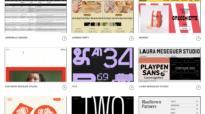Rebrand ignites debate about Canadian institutions hiring international design firms—and vice versa

We asked RGD Members from across the country to weigh in on the National Gallery of Canada's procurement of a US agency for their rebrand. This is a complex issue involving a national institution, Indigenous cultures, taxpayer funds, global ambitions and our own Canadian identity.
As a first step in unpacking this, the RGD reached out to the National Gallery of Canada (NGC) directly for clarification on their procurement process: six firms were contacted, four of which were based in Canada. The winning agency, Area 17 (NY/Paris), has three partners, two of whom are Canadian. Below is the full statement from the NGC, along with statements from nine RGD Members. Opinions vary, but it is clear that these issues about Canadian design talent and global procurement will not disappear any time soon.
This piece was inspired by our own Members raising questions about our national design talent and protectionism. Should RGD and the Canadian design community be doing something to ensure Canadian agencies are hired for these sorts of projects in the future? Have your say and contact the RGD at president@rgd.ca.
Contributors
Matthew Clark RGD, Founder & Creative Director at Subplot in Vancouver
“Although the agency lead is Canadian, given the gallery’s diligence and consultation, it would seem obvious that a Canadian firm would be the logical choice. Canada boasts world-class Branding Agencies but to many Canadian companies, there is an “inferiority complex” about being Canadian. We see this time and time again: local and national Canadian companies going stateside for creative. Somehow, using a US or international firm makes Canadian organizations feel bigger and better. More “global.” But a simple survey of leading Canadian firms shows many with global client rosters and great creative in their portfolios.
Maybe that’s the double-edged sword of globalism. In the same way we at Subplot certainly have US and Global clients in our portfolio, should it be equally acceptable for a US firm to have Canadian clients? Is “good work” the point, wherever it comes from? Maybe. But in my opinion, a Canadian firm absolutely should have been awarded this contract, not for some symbolic tokenism, but because it aligns with the Gallery’s vision AND because there is plenty of talent to choose from right here at home.”
Jennifer Taback RGD, Principal at Design de Plume Inc. in Sudbury
“The fact that the National Gallery of Canada did not select a Canadian firm, or an Indigenously-led firm is disappointing for a publicly-funded institution. While I appreciate their process and the fact that they included Elders and thorough input, part of Reconciliation means developing relationships with Indigenous vendors who can provide those same services and be appropriately compensated for it. It also suggests that no one in Canada is capable of performing this important work and makes it difficult to encourage Indigenous business to continue, when organizations like this simply do not place value on putting their money where it can make a difference in so many ways.
Rebranding and renaming in a way that recognizes Indigenous contributions is only one of the most basic steps that can be taken. The next steps are supporting Canadian design firms (especially Indigenous firms) by providing pathways to do the actual work. Consultation is one thing, but our communities need more than being just advisors. We need to be part of the work.”
Franziska Erlebach RGD, Design Director at Sid Lee in Toronto
“Canadian firms are known for bringing diverse perspectives and cultures to their work. That being said, great branding is borderless and a collaborative effort. Adhering to artificially created borders is not a future-facing path in general; bringing people from different nationalities, backgrounds, diverse perspectives and experiences together is the fuel for truly meaningful and outstanding design work. The new visual identity for the National Gallery of Canada (NGC) provides an excellent example of this: created by AREA 17, a US agency led by a Canadian CCO, it was informed by a wide range of inside and outside perspectives e.g. Indigenous artists, Algonquin elders, staff and other cultural institutions. Because of the NGC’s position as a national institution, however, there may be some who question in this case whether a Canadian firm should have been selected for this opportunity.
Let’s take a step back for a moment. The purpose of the National Gallery of Canada “...is to nurture interconnection across time and place, to amplify the voices of the communities that they exist to serve.” With that in mind, the NGC selected the most suitable partner that they felt would guide them and collaborate in bringing their vision to life. Why should they restrict themselves based on artificially created territories to make the selection process harder than it is already, in particular when we talk about government-funded institutions, where the selection process is more complex? Certainly, cultural institutions may make a conscious decision to work only with firms located in their own country, even locally, but should that be the standard for all?”
John Furneaux RGD, Principal at B3 Strategy in Toronto
“I had mixed feelings when I heard that the new identity for the National Gallery of Canada had been created by Area 17. On the one hand, as many Canadian design firms, including my own, do work for clients based in the US and Europe, it would be hypocritical of me to say that all design work done in Canada must be done by Canadian firms.
HOWEVER, the National Gallery is an important Canadian institution; it helps define and influence how we see ourselves. While Area 17 is a top-tier firm that specializes in cultural institution branding, the hiring of a US firm to without a Canadian design firm on the team seems at odds with the gallery’s stated strategy of inclusion.
While large public institutions need to be free to hire the best firms no matter where they are, there are ways to do this while still ensuring that Canadian talent are present at the table throughout the creative process. One possible solution is the requirement that, on large publicly-funded branding projects any design firms based outside of Canada must partner with a Canadian run (and owned) firm on the project. This practice is common in other design-based professions such as architecture, where commissions are often joint ventures that produce a number of benefits.
So, while I think that the end product that was developed is well thought through and well executed, we have missed the opportunity for underrepresented Canadian designers to have a voice at the creative table when ideas are being developed. Just imagine, if Area 17 had partnered with an up-and-coming Canadian design firm, this Canadian firm would have received amazing experience and exposure to allow them to expand their practice. And for now, that’s all we can do, just imagine.”
Vida Jurcic RGD, Founding Partner at Hangar 18 Design Continuum in Vancouver
“I think the new branding for the The National Gallery is brilliant. It’s dynamic, modern yet not trendy, and truly represents the kaleidoscope of cultures and stories that make up our diverse country. The fact that it is a powerful nod to Indigenous culture makes it all the more compelling.
I am a Canadian designer, but I am not a Canadian by birth. I was born in Australia to Croatian parents; I moved to Canada in 1974. The fact that the National Gallery chose a US design firm to re-brand the The National Gallery is not ideal, but not surprising given the cutting edge calibre of work that Area 17 produces, and their strong focus on branding and digital product. There are of course any number of world-class design firms in Canada who would have done a wonderful job too, but at the end of the day, Area 17 were a great choice. Founding partner of Area 17, Kemp Attwood was raised in Canada. So who is more Canadian? A designer born elsewhere living in Canada, or a Canadian now abroad?
We live in a global society, and borders should not keep us from bringing in the finest talent for the job. Do we not bring in Swedish players for our hockey teams? While focusing on Canadian artists, The National Gallery also shows international work. Many of Canada's pioneers of design are immigrants: Carl Brett (Ireland), Peter Dorn (Germany), Leslie Smart (Great Britain). They brought modernism and the International Typographic Style, and helped influence the trajectory of Canadian design. We, as designers, need to acknowledge our Canadian contributions to design, but we also need to think globally, and embrace some of the design thinking from further afield. Looking in your own backyard is probably the first thing we do, but it is also limiting for all of us. Which one of us could honestly say that we would not jump at the chance to re-brand the MoMA? Let’s keep the global dialogue open.”
Howard Poon RGD, VP of Design at DDB in Edmonton
“The National Gallery’s elegant new brand is visual proof of their successful collaboration with Area 17. It’s a world-class rebrand. Could a Canadian firm been delivered a solid solution for the National Gallery rebrand? Yes, without a doubt. Should the Gallery have hired a Canadian firm? The answer is not black-and-white. There is no mention of a Canada-first supplier policy in the museum’s Procurement Policy (March 20, 2018). According to the guidelines, the objective of the government procurement contracting is to acquire goods and services in a manner that encourages competition and fairness, “and results in best value or, if appropriate the optimal balance of overall benefits to the Crown and Canadians.” I fully trust that the museum’s rebrand team followed a fair, open and transparent procurement process. And, while I believe working with a Canadian firm would have checked off the ‘Support Local’ box on a list of procurement selection criteria, I support an open, competitive talent market—one that includes opportunities for Canadian agencies to continue to participate in global project tenders.”
Ashlea Spitz RGD, Principal / Creative Director at Pixsoul Media Inc. in Vancouver
“The National Gallery of Canada is home to the world’s most comprehensive collection of Canadian art, so it came as a surprise that a US agency was selected to redesign the face of a Canadian core brand. By proclamation of the Museum’s Act, the National Gallery of Canada is a Crown Corporation of the federal government which has strict procurement policies in place. However, an exception to their procurement policy is that these policies “do not apply to any design services or work” (sec. 3.3 b).
The National Gallery of Canada has a mandate to protect and promote Canadian culture so choosing an out-of-country agency to design the face of their brand seems to contradict the core values that the Government of Canada’s “Creative Canada” promotes. Creative Canada defines the blueprint for federal policy tools that support our creative industries. The vision and approach to creative industries is to build on success and position Canada as a world leader by putting its creative industries at the centre of its future economy and to grow the creative economy collectively. Museums have always been key partners with our creative industries. So investing in our designers not only helps to promote Canadian designers, it creates an impact for Canada’s identity on a national and international stage. However, having a US firm head the branding of a Crown Corporation, uniquely positioned in the creative space with a vast audience, undercuts the significance and growth of our Canadian creative communities.
If we know that the economies of the future will rely on creativity and innovation to create jobs and foster growth, then we must support our creatives and emphasize that creatives are ambassadors for our country. If we are not practicing these principles then where do we go from here?”
Laura Stein RGD, Executive Creative Director at Bruce Mau Design in Toronto
“The National Gallery of Canada should not have felt obliged to work with a Canadian firm on their new branding. There is probably an argument that a Canadian firm would be better suited for a job like this by virtue of understanding the context. But another way of looking at it is that there can be value to bringing in outsiders – with fresh eyes and without deeply ingrained ideas. This is not to say that the outsiders stay outsiders. They need to work hard to get to know a place through research and immersion, and be attuned to working in different cultures.
In our work at bmd, we often collaborate with clients in different parts of the world, on cultural and place branding projects. We spend what sometimes seems like an inordinate amount of time considering the right tools and processes to help us better understand each place in which we work. Last year, we designed the identity system for Zayed National Museum in the United Arab Emirates. At the same time, we developed the framework and identity for a large-scale greenway project in St Louis, Missouri. Each of these projects demanded a specific set of activities to get to know the history, the audiences, and the potential of the project. We also had to understand the cultural fabric and how our work would add to that fabric in the future. It sounds like Area 17 also approached this project with those things in mind and convinced their clients that they would tackle the work with all the curiosity and sensitivity that it required.”
Eric Pellerin, Head of Scenography and Media Production at Canadian Museum of History
"The National Gallery of Canada, like all other Crown Corporations, falling under the Museum Act, must abide by many obligations and regulations. Like others, they are also under the Financial Administration Act, which dictates how they control and administer their finances. For the in-house managerial staff in charge of the rebrand, this means that there are many important considerations to be made when tackling such a capital project.
Financially and contractually, it means that there are a certain bureaucratic set of strict rules that will take place during the procurement process. A thorough comprehensible scope of work was written, vetted internally by decision makers. These are publicly published on a platform (think MERX for instance), so that anyone can have a chance at making a proposal. Their responses is a lengthy document that follows the process highlighted in the scope of work, where all details matter. These firms have to pass through an evaluation that will examine everything, and I mean everything: credentials, portfolios, bios of key members of their teams, description of their creative process, comprehension of the project, ventilation of their fees, proposed development calendar, etc., etc., etc.
As someone who works in a national museum, I often take part in such evaluation committees. While our processes ensure a fair look at all proposals, it can also look like a vacuum where fundamental aspects of a project are overlooked. Was the chosen firm the most creative? Did they have an innovative approach to consultations? How big is their staff that would work on the project? Were they the most affordable? Could they deliver faster than anyone else? These are likely only a few of the many other evaluation points that set the winning proposal’s final score. Given the importance of the project at hand, being a Canadian firm cannot be the evaluation point that can trump all.
Knowing the process from within, I have full trust that the choice was fair and that the firm worked hand in hand with the National Gallery to consult with all stakeholders. The end result is a brand that works, beautifully."
Dave Hollands, Head, Creative at the Royal Ontario Museum in Toronto
"Canadian cultural institutions funded in whole or in part by taxpayers are mandated to procure services that optimize the outcome for their users and funders. This begins with a fair and open process that weighs talent, experience, cost and other factors. I believe Canadian suppliers must always be given equal access, but not always to the exclusion of casting a wider net. In the same way Canadian designers ought always to be able to pitch their services and win projects on the global stage.
It is contingent on the client to set the terms for appropriate local consultation, response and relevance no matter where the designer is from and, frankly, I have always scored design proponents higher if they show real sensitivity and experience in this area. The National Gallery rebrand result reads as thoughtful in this way.
And structurally, if a Canadian cultural institution wants to give priority and affirmative action to any kind of supplier, say a design team with Indigenous or Canadian members, then their requests for design proposal can always be transparently structured to award points accordingly."
From the NGC
Kemp Attwood, Founding Partner, CCO at AREA 17 in New York City
“I've always seen Canada not as a melting pot, but as a mosaic and quilt of cultures that is ever-changing. This was key to the expression of the National Gallery—ensuring we didn't project a monolithic view of Canada. We were inspired by the diversity of voices that come together to make something larger and dynamic. Moving the National Gallery of Canada from a square to a permeable circle was at the centre of the rebrand, providing a space for all perspectives to be seen and heard. So this dialogue is healthy. It is at the center of what the National Gallery of Canada represents — how art crosses time and place and shows the limitless connections that exist beyond the frame of one perspective. As a Canadian, this is one of the proudest moments of my career. I was personally thrilled for the opportunity to help one of Canada’s most preeminent institutions represent all of Canada on the world stage.”
Rosemary Thompson, Vice President Corporate, Public Affairs and Marketing at the National Gallery of Canada in Ottawa
“More than a year ago, the National Gallery of Canada embarked on a major Strategic Planning process that engaged the entire organization. Through the Strategic Plan, the Gallery committed to opening up to a diversity of voices to reflect the changing nature of Canada. As the Strategic Planning process evolved, the Gallery decided that it needed a new visual identity and institutional voice to reflect where it was going.
In December, the Gallery invited six firms to submit proposals; four were Canadian, two were US based. In the end 5 firms sent formal submissions to be considered. The Gallery was looking for some key elements for the project. We needed a team that understood the Gallery and where it was going; we were looking for experience in the museum sector in Canada or internationally; we needed an agency that could operate seamlessly in Canada’s two official languages; and we wanted a team that was strong digitally.
Of the five agencies that submitted proposals, Area 17 stood out. Not only did the agency have deep experience in Canada, the US and France, two of its three Founding Partners are Canadian. Chief Creative Officer Kemp Attwood grew up in North Bay, studied at York University and the Bell Centre for New Media and Interactive Design in Toronto and then worked as a designer in Vancouver. His work with CBC’s Radio 3 garnered awards from the New York Festivals, Art Directors Club and Communications Arts. His team was fully bilingual, understood the cultural moment and works in Canada, the United States and France.
'As a global brand and digital product agency that works with cultural organizations around the world, the opportunity to rebrand the National Gallery of Canada resonated with us in a personal way. 2/3rds of our partners are proud Canadians and are deeply connected to the mission and vision of The National Gallery of Canada,' said Kemp Attwood, Chief Creative Officer and Co-Founding Partner at AREA 17.
Kemp himself has created websites and museum installations for the National Geographic Society, the Smithsonian Institution and the United States Holocaust Memorial Museum. He has served as an invited speaker by Canadian organizations including the RGD's own DesignThinkers Conference. Area 17 is working with many cultural organizations around the world including: The National Museum of Mexican Art, The Getty Museum, The Art Institute of Chicago and l'Opéra de Paris.
The team worked seamlessly with the National Gallery to interview 350 people inside and outside the Gallery to determine where the new visual identity should go. That process included engaging with four Indigenous Elders, Artists and Knowledge Keepers from the unceded territory where the Gallery is situated. The Indigenous Advisory Council guided the new visual identity and voice to the concept of “connection”, and over the months of discussion an Anishnaabemowin word emerged, “Ankosé” which means “Everything is Connected,” “Tout est Relié.” A concept that beautifully symbolizes the Gallery’s new Strategic Vision and Purpose. The new visual identity and voice launched on June 23, 2021 outside the Gallery with the Elders present. There was a ceremony to begin a new chapter together and to live into the concept of Ankosé. It was a gentle and compassionate morning, one filled with gratitude for everyone who worked on the project.
The new visual identity was warmly received by the Elders, staff and public. We are thankful for everyone who worked on this project, including Area 17, as they were careful listeners, had deep roots in Canada and were guided by the hundreds of Canadian voices that participated in this journey.”
Tags
Related Articles


Dave Dick RGD, Derwyn Goodall RGD, Michaella Kruizinga Associate RGD, Philip Mondor RGD


Samiksha Makhijani RGD, Deanna Loft RGD, Reesa Del Duca RGD, Allison Charles, Crispin Bailey RGD












